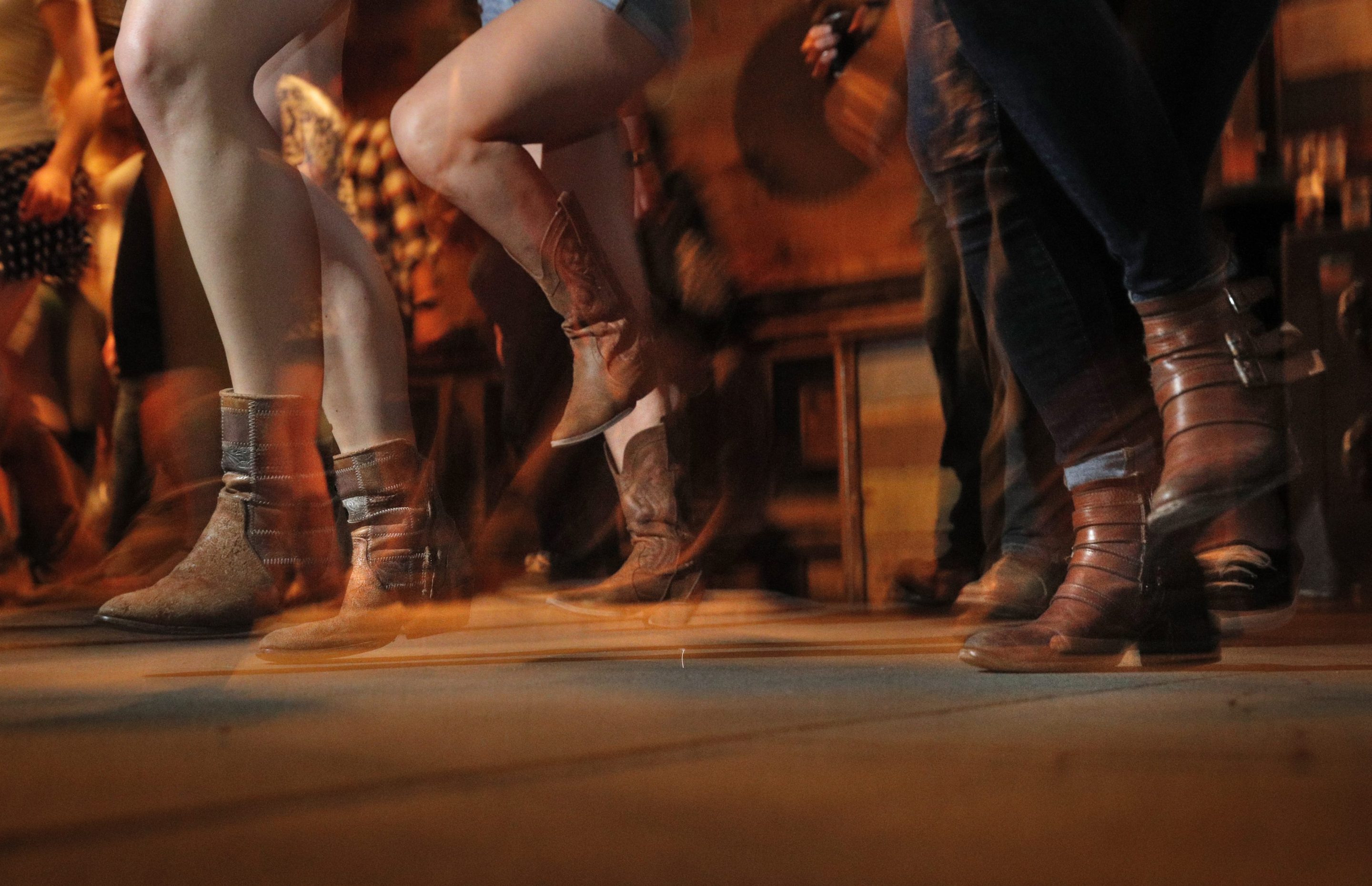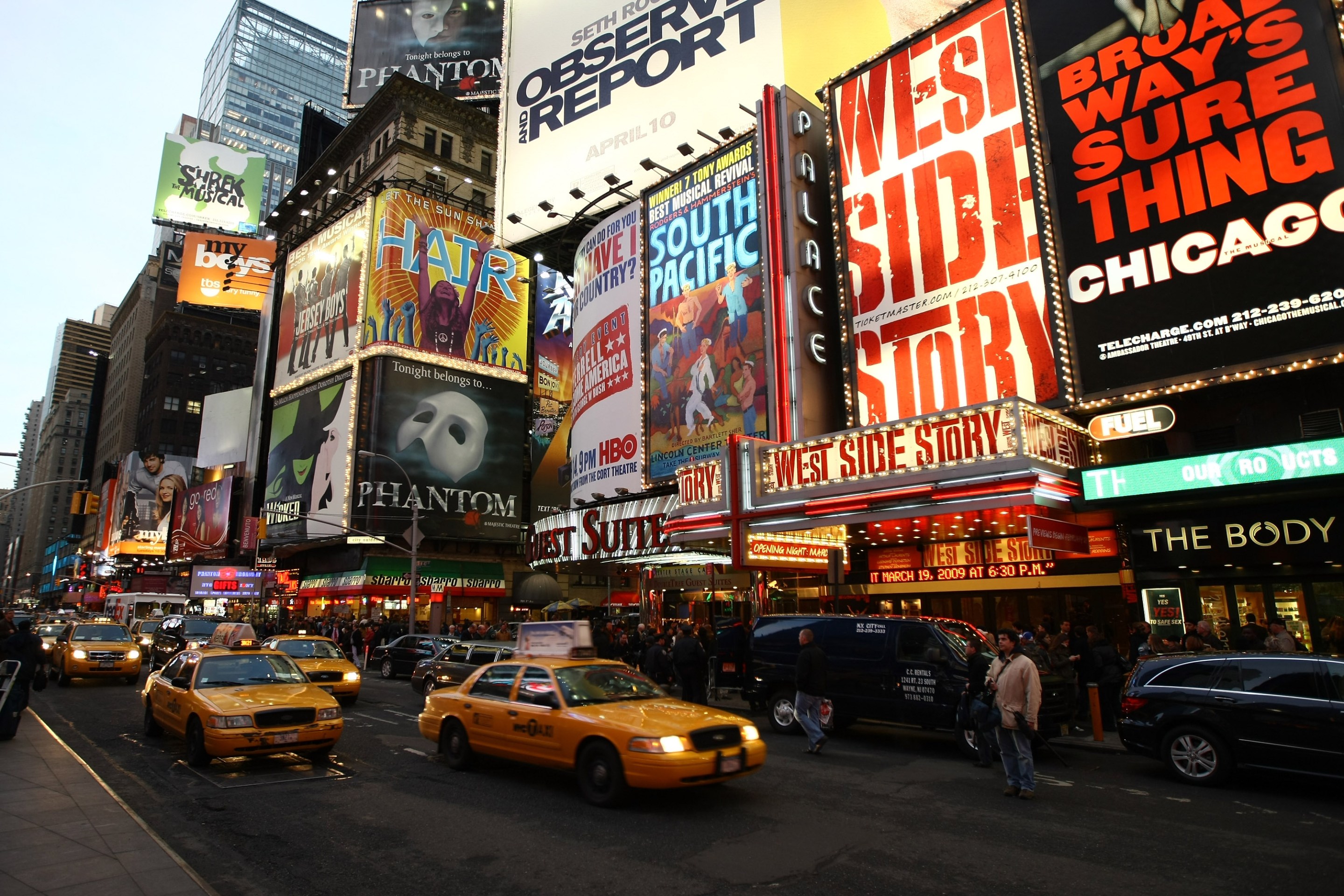On a breezy spring night in 2023, the Georgia Room at the Freehand Hotel was humid with sweat. Queers of various genders wore cowboy hats and bedazzled denim, camouflage and American flag bikinis. The lights were low and clubby. A New York Times reporter milled around with a notepad. This was Stud Country, a queer line dancing night that began in Los Angeles but had begun migrating, every month or two, to New York. The hosts, Sean Monaghan and Bailey Salisbury, began the night by teaching a line dance to “Texas Time” by Keith Urban, an Australian man singing about his need to be in the Lone Star State, at least energetically: “New York girls, they can be so pretty / But I get cold living in the city.” This campy geographical incongruity felt fitting for an event hosted in a chain boutique hotel in Manhattan.
When a friend floated the ticket link in the group chat, it sounded right up my alley: I’m an insufferable Brooklyn bisexual who took 12 years of ballet and spent every Sunday of my childhood performing onstage. I went to a Southern state school for college, so country radio imprinted itself on me before my brain was fully formed. Eight counts in, I was hooked. Gay line dancing is nothing new, but it’s a thrilling community to dive into. It was exciting to have a queer space that’s gender-diverse and not particularly boozy. Plus, country music isn’t so far from drag: All those big trucks, cold beers, boat parties, and jilted lovers wear the patina of cliché with a wink.
Stud Country, which launched in Los Angeles in 2021, is friendly to the beginner but lousy with devotees who know every step and potential piece of slutty flair. Each event usually includes two lessons, where teachers onstage guide the room through a dance, proving to newcomers that competence is achievable. Each dance (usually 32 counts) is choreographed to one specific song, and is repeated over and over until the song ends. The rest of the night, regulars spin and stomp and clap and slide en masse to country hits (Kenny Chesney, The Chicks, Luke Bryan) and pop bangers (Charli XCX, Troye Sivan, Daddy Yankee) alike. Watching a few dozen people dance in perfect sync to Ke$ha’s “Take It Off” is electrifying, mesmerizing, jealousy-inducing; Stud LA regular and occasional choreographer Corey Lubowich likens it to observing “a school of fish.” Fast learners can try to pick up the dance by sight from the sidelines and slip into the wave of bodies before the song ends. Here, you can experience the euphoria of acquiring a new skill multiple times a night.
A few friends who came to the Georgia Room that night were turned off: Too crowded, one said; another has since called it “fascist” because “they won’t let me just dance to the song on the dance floor.” But some of us committed to line dancing every month or so, and we learned the rules fast: First, no drinks on the dance floor; second, if you don’t know the dance, stand to the side—otherwise you’ll accidentally elbow someone while Kacey Musgraves’ “High Horse” plays.
In the last four years, Stud has blown up: The founders landed a feature in the Times, danced on The Today Show, and hosted a lesson for Nike. Thanks in part to this ascendance, new queer and queer-friendly line dancing nights have proliferated through New York more recently. Most weeks it’s easy to spend three or four nights dancing, if you’re so inclined; given how many people seem to have a hundred dances memorized, it seems like many do. In the East Village, dancer and choreographer Tenaya Kelleher has developed a loyal following for her weekly classes in the ballroom of the Ukrainian East Village Restaurant—which is less a party and more a (fun, crowded) class for hardcore dancers who have committed to learning every step. To land a ticket, I need to set an alarm for noon the day beforehand, or reservations are gone. On Sunday nights in Williamsburg, Buck Wild offers a cuntier option at Desert 5 Spot. And then there’s Big Apple Ranch, a twice-monthly line and partner dance event that’s been going strong for nearly three decades. New York’s options feel like a representation of the fact that line dancing has gone global. For a while, I kept seeing an Expedia ad directed by Hiro Murai where friends in Japan book a trip to visit a stateside honky-tonk.
Stud Country emerged after the closure of Oil Can Harry’s, a longstanding gay country bar in LA. Monaghan and Salisbury had met there, and wanted to carry on the tradition of queer line dancing (and two-stepping) in the city: maintaining an intergenerational space where the Oil Can regulars could keep dancing, and where their friends would want to hang. When they began their weekly party at Club Bahia in Echo Park after the pandemic lockdown ended, it took off immediately. In many ways, the line dance floor echoes the logic of a nightclub: the warm forgiving smile when someone accidentally bumps you in an ecstatic twirl, the covert eye-roll sent to a friend after regularly side-stepping someone with zero spatial awareness. Monaghan and Salisbury have a knack for vibes, and their parties emphasized sexy lighting and sartorial expression.
The pleasure of mastery and the endless number of dances to learn make obsession and loyalty a natural response to the phenomenon of line dancing: The more often you go, the easier it is to remember what you learned. The more dances you see other people know, the more you want to memorize. Finally I understand the desire to master a TikTok dance, or why my (white) college boyfriend was obsessed with the Cupid Shuffle: the shared performance of synchronicity supersedes any fear of cringe. Plus, most people look cool in cowboy boots. As Lubowich explained to me over the phone, line dancing also lets us “physically experience music in a different way. And after you learn the steps, you don’t have to think about it—you get into this sort of zen flow state.” With a quick self-conscious laugh, he calls it a “brain douche.” That ecstasy is amplified by the communal element—it’s no fun to line dance solo.
The traditional steps that make up line dances are like mutable building blocks. If you ever did the Cotton Eye Joe at a middle school dance or watched The Accountant 2 while very stoned, you’ll recognize the basics: shuffles, box steps, grapevines, spins, every sort of step-ball-change you can imagine, and the “hitch,” where you tap your heel in front of you and cross it over your opposite knee. Dances choreographed to newer dances still look like older dances, though some of the new stud-adjacent choreography has brought in some extra flair: I’m desperate to learn the dance to HARDY’s country-metal “Truck Bed,” which includes a brief headbang.
At Stud and its offshoots, the practice of “swaps”—doing an older dance to a more contemporary, or gayer, song—has become a crucial, though occasionally controversial, practice. Swaps can be pure fun, as in the case of “Jambalaya,” a dance choreographed to a Cajun romp of the same name that lets you carry the centrifugal force of your body around to Troye Sivan’s “Rush.” But they can also break the contract between song and dance, fitting a square peg into a rectangular hole. “If a dance was choreographed well,” Lubowich said, “it’s going to feel really good to do it to the original song—there’s an interaction and a vibration between the choreography and the music that amplifies each other.”
A week or two after Donald Trump’s inauguration this year, I went with some friends to Buck Wild in Williamsburg. I hadn’t realized how bad my body had been feeling until I was halfway through my first dance. The repetitive nature of line dancing can feel like a trance, a ritual, an exorcism. Your body takes over from your mind. You are dropping it low as Morgan Wallen warbles, “There’s two things that you’re gonna find out / They don’t love you, and they only love you right now.” (The greater gay line dancing community seems to have reached a detente with the ever-problematic Wallen.) There’s something about line dancing that allows your body to chuckle at country music’s incessant wordplay.
And then there’s Ed Sheeran’s “Shivers,” a song that I never would have thought twice about before learning the ass-shaking, mambo-tinged dance that accompanies it. Lubowich has danced to “Shivers” in London, in Australia, in straight clubs and gay clubs alike—“it is the global line dance,” he said, calling it “wholesomely horny.” It’s neither complex or overly simple, and it has never gotten old. Ooh, I love it when you do it like that, Sheeran sings, somehow convincingly, and a room full of gay people slap their quads, stomp their feet, and circle their hips, catching their breath before spinning again.







